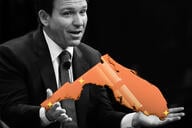You have /5 articles left.
Sign up for a free account or log in.
It may not be the $200,000 that Benjamin Ladner, the ousted American University president, spent on drainage and landscaping, but a $30,000 dog fence does have a way of irking the taxpaying masses.
That’s one of the additions the University of California at Santa Cruz made to chancellor Denice Denton’s campus home last year before she moved in. Newspaper reports and legislator’s questions have characterized the renovations and additions, which were slated to reach up to $600,000, as profligate spending. The reports come amid general legislative concern about spending by California administrators. But university officials said that the changes were primarily needed renovations.
In a State Senate hearing, Robert Dynes, president of the University of California system, had to explain to legislators that the dog run was “a project that just got out of whack.”
As a result, Dynes now has to personally approve all home-improvement projects at all UC campuses that are in excess of $25,000, apparently below the amount needed to construct a serious doggie playpen.
Reports in the San Francisco Chronicle have characterized a list of alterations -- from a subzero refrigerator to a bigger dining table in the hosting area of the house -- that Santa Cruz released as Denton’s “demands” -- worthy of Extreme Makeover Home Edition.
Beyond the perimeter dog fence, however, Chris Harrington, a university of California spokesman, said in an e-mail that the changes to University House were “a combination of deferred maintenance improvements that campus staff recommended, plus items that were needed to accommodate the new chancellor's living situation.” According to the Santa Cruz Web site, University House has had only “occasional repairs and alterations since” it was built in 1966.
The site adds that the projected will be paid for by “funding allocated for the projects…from a private endowment fund.”
Raymond D. Cotton, a Washington lawyer who specializes in presidential contracts, recommends that institutions do major home improvement work “in the last year of a presidency, or between presidencies, so that the individual incumbent doesn’t suffer because of needed improvements.”
Harrington said that California commonly heeds that advice.
Cotton added that improvement projects -- don’t tell Ladner -- often go over easily at private institutions, but with publics, “state legislators somehow view a home that is owned by the university as personal to the incumbent, instead of viewing it as another university building like a lab, gym, or library.”
Cotton recounted a case in which he said the previous president of Towson University had home improvements done that exceeded $1 million because they included asbestos abatement. Cotton said that president ultimately lost his job because of negative coverage in The Baltimore Sun of the home-improvement project. “The current president who lives in the improved home has suffered no criticism whatsoever,” he added.
Many of the improvements on the list were slated for the 4,214-square-foot public section “public area” of University House, where special events are held. Harrington added that, in order to keep with the designated funding, some of the improvements, such as a new sound system, never went through.




